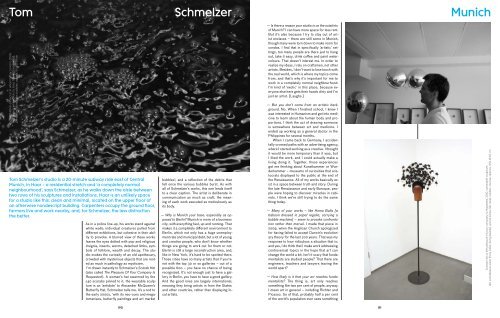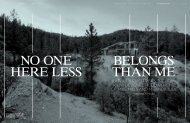munich - Katya Tylevich
munich - Katya Tylevich
munich - Katya Tylevich
Create successful ePaper yourself
Turn your PDF publications into a flip-book with our unique Google optimized e-Paper software.
Tom Schmelzer<br />
Responsibility-to-protect or to whom it may concern, 2008,<br />
installation, white oildrum, Jesus figures (silver/metal),<br />
petroleum, pump, gas bubbles, approx. 110 x Ø 58 cm<br />
Tom Schmelzer’s studio is a 20-minute subway ride east of Central<br />
Munich, in Haar – a residential stretch and ‘a completely normal<br />
neighbourhood’, says Schmelzer, as he walks down the aisle between<br />
two rows of his sculptures and installations. Haar is an unlikely space<br />
for a studio like this: clean and minimal, located on the upper floor of<br />
an otherwise nondescript building. Carpenters occupy the ground floor,<br />
farmers live and work nearby, and, for Schmelzer, the less distraction<br />
the better.<br />
As in a police lineup, his works stand against<br />
white walls: individual creatures pulled from<br />
different exhibitions, but cohesive in their ability<br />
to provoke. A blurred view of these works<br />
leaves the eyes dotted with pop and religious<br />
insignia, insects, worms, detached limbs, symbols<br />
of folklore, wealth and decay. The studio<br />
evokes the curiosity of an old apothecary,<br />
crowded with mysterious objects that are rooted<br />
as much in pathology as mysticism.<br />
I’m drawn instantly to Schmelzer’s Scarab Hat<br />
(also called The Pleasure Of Your Company Is<br />
Requested). A woman’s hat swarmed by the<br />
140 scarabs pinned to it, the wearable sculpture<br />
is an ‘antidote’ to Alexander McQueen’s<br />
Butterfly Hat, Schmelzer tells me. It’s a nod to<br />
the early 2000s, ‘with its neocons and megalomaniacs,<br />
butterfly paintings and art market<br />
bubbles’; and a reflection of the debris that<br />
fell once the various bubbles burst. As with<br />
all of Schmelzer’s works, this one lends itself<br />
to a clear caption. The artist is deliberate in<br />
communication as much as craft, the meaning<br />
of each work executed as meticulously as<br />
its body.<br />
— Why is Munich your base, especially as opposed<br />
to Berlin? Munich is more of a business<br />
city, with everything fast, up and running. That<br />
makes it a completely different environment to<br />
Berlin, which not only has a huge unemployment<br />
rate and municipal debt, but a lot of young<br />
and creative people, who don’t know whether<br />
things are going to work out for them or not.<br />
Berlin is still a large reconstruction area, and,<br />
like in New York, it’s hard to be spotted there.<br />
Those cities have so many artists that if you’re<br />
not with the top 30 or so galleries – out of a<br />
possible 600 – you have no chance of being<br />
recognized. It’s not enough just to have a gallery<br />
in Berlin, you have to have a good gallery.<br />
And the good ones are largely international,<br />
meaning they bring artists in from the States<br />
and other countries, rather than displaying local<br />
artists.<br />
— Is there a reason your studio is on the outskirts<br />
of Munich? I can have more space for less rent.<br />
But it’s also because I try to stay out of artist<br />
enclaves – there are still some in Munich,<br />
though many were torn down to make room for<br />
condos. I find that in specifically ‘artistic’ settings,<br />
too many people are there just to hang<br />
out, take it easy, drink coffee and paint watercolours.<br />
That doesn’t interest me. In order to<br />
realize my ideas, I rely on craftsmen, not other<br />
artists. Besides, I don’t want to lose touch with<br />
the real world, which is where my topics come<br />
from, and that’s why it’s important for me to<br />
work in a completely normal neighbourhood.<br />
I’m kind of ‘exotic’ in this place, because everyone<br />
else here gets their hands dirty and I’m<br />
just an artist. [Laughs.]<br />
— But you don’t come from an artistic background.<br />
No. When I finished school, I knew I<br />
was interested in Humanism and got into medicine<br />
to learn about the human body and proportions.<br />
I think the act of drawing someone<br />
is somewhere between art and medicine. I<br />
ended up working as a general doctor in the<br />
Philippines for several months.<br />
When I came back to Germany, I accidentally<br />
crossed paths with an advertising agency,<br />
where I started working as a creative. I thought<br />
it would be more temporary than it was, but<br />
I liked the work, and I could actually make a<br />
living doing it. Together, those experiences<br />
got me thinking about Kunstkammer or Wunderkammer<br />
– museums of curiosities that aristocrats<br />
displayed to the public at the end of<br />
the Renaissance. All of my works basically exist<br />
in a space between truth and story. During<br />
the late Renaissance and early Baroque, people<br />
were hoping to discover miracles in cabinets.<br />
I think we’re still trying to do the same<br />
thing today.<br />
— Many of your works – like Homo Bulla [a<br />
baboon dressed in papal regalia, carrying a<br />
bubble machine] – seem to provoke confrontation<br />
rather than marvel. I made that piece in<br />
2009, when the Anglican Church apologized<br />
for having failed to accept Darwin’s evolutionary<br />
theory for the last 200 years. That was my<br />
response to how ridiculous a situation that is;<br />
and yes, I do think that I make work addressing<br />
controversial topics in the hope that art can<br />
change the world a bit. Isn’t it scary that fundamentalists<br />
are studied people? That there are<br />
engineers, teachers and lawyers tearing the<br />
world apart?<br />
— How likely is it that your art reaches fundamentalists?<br />
The thing is, art only reaches<br />
something like two per cent of people, anyway.<br />
I mean art in general – including Richter and<br />
Picasso. So of that, probably half a per cent<br />
of the world’s population ever sees something<br />
190 191<br />
Munich<br />
Scarab Hat or the pleasure of your company is requested, 2010, wearable sculpture,<br />
140 scarabaeus sacer (holy roller, dung beetle), wood, brass, felt, steel, rubber, viscose, approx. 195x Ø 65 cm



